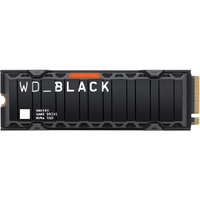This week it's all about Amazon Prime Day 2 (as I like to call it), or Amazon Prime Big Deal Days (as Amazon prefers to officially call it), with some of the best deals expected between now and the event's close at the end of Wednesday 11 October.
I've set up alerts and scoured Amazon for some of the best deals in tech and have stumbled upon this little gem for those PlayStation 5 users looking to upgrade: the officially licensed WD_Black SN850 SSD, in its 1TB form, has a stellar 50% cut from its asking price.
WD_Black SN850 for PS5: was £179.99, now £89.99 at Amazon.co.uk
If you're looking to expand your PS5's storage using an officially licenced SSD then the Western Digital range is just the ticket. Its SN850 range complete with heatsink is ideal and we're now seeing prices cut by half, such as this 1TB model with 50% off the list price. Bar-gain!
I've previously installed a WD_Black SN850 into my own PS5 – here's a step-by-step picture guide to make it easy – and have been impressed by the additional storage capacity. I bought a 500GB one, though, which at the time cost about the same as this 1TB option!
The WD_Black options are officially licensed for PlayStation 5, as they come with a built-in heatsink, and hit the required read/write rates that are specific to PS5, in order to be able to nest information between that and on the on-board superfast SSD, which is a requirement for certain games to run correctly.
I think the asking price is solid, too, although having looked on CamelCamelCamel (the price-monitoring site) interestingly the same drive was a fiver cheaper for a brief spell just last month. That does give me hope that it'll drop again for Big Deal Days proper – so if you're not yet committed to buy today then you can use this Amazon Alexa hack to highlight deals and price drops for you. Happy shopping, fellow gamers!
Sign up to the T3 newsletter for smarter living straight to your inbox
Get all the latest news, reviews, deals and buying guides on gorgeous tech, home and active products from the T3 experts

Mike is T3's Tech Editor. He's been writing about consumer technology for 15 years and his beat covers phones – of which he's seen hundreds of handsets over the years – laptops, gaming, TV & audio, and more. There's little consumer tech he's not had a hand at trying, and with extensive commissioning and editing experience, he knows the industry inside out. As the former Reviews Editor at Pocket-lint for 10 years where he furthered his knowledge and expertise, whilst writing about literally thousands of products, he's also provided work for publications such as Wired, The Guardian, Metro, and more.
-
 Mous Optimal Travel Backpack review: this alternative to wheeled hand luggage is perfect for business trips
Mous Optimal Travel Backpack review: this alternative to wheeled hand luggage is perfect for business tripsThe Mous Optimal Travel Backpack is the ideal carry-on when taking a large laptop and lots of tech on a business trip
-
 I think this might be the biggest Netflix teaser ever
I think this might be the biggest Netflix teaser everSquid Game's final season will do huge numbers
-
 Don't buy this cheap Apple Watch dupe – the real deal is discounted at Amazon!
Don't buy this cheap Apple Watch dupe – the real deal is discounted at Amazon!It's easy to be swayed by a bargain, but the real deal might be better here
-
 My favourite arcade machine of all-time is down to its lowest price ever
My favourite arcade machine of all-time is down to its lowest price everSave £100s / $100s on Arcade1Up cabinets during Amazon's spring sale – including Star Wars
-
 Quick! This stunning Bang & Olufsen Bluetooth speaker is $200 off, but it'll be gone tomorrow!
Quick! This stunning Bang & Olufsen Bluetooth speaker is $200 off, but it'll be gone tomorrow!The Beolit 20 is one third off right now
-
 This monster 77-inch Samsung OLED TV is less than half price for Cyber Monday – that's crazy!
This monster 77-inch Samsung OLED TV is less than half price for Cyber Monday – that's crazy!You can get $1,700 off the Samsung Class S84D OLED at Best Buy right now
-
 I love this mini retro games console and this big deal makes it the ideal Christmas present
I love this mini retro games console and this big deal makes it the ideal Christmas presentThe NeoGeo Mini is a superb buy with £15 off – comes with 40 games and its own screen
-
 Is there a DJI Neo drone deal on Black Friday? Here's what I found
Is there a DJI Neo drone deal on Black Friday? Here's what I foundThe brand's top-selling dinky drone might not be any cheaper for Black Friday, but there are a ton of exciting DJI offers to choose from
-
 Samsung's latest iPad rival just dropped to its lowest-ever price in great Black Friday deal
Samsung's latest iPad rival just dropped to its lowest-ever price in great Black Friday dealYou’re running out of time to save money on a new tablet
-
 Samsung's 5-star style TV has fallen to a record-low price – it's my dream TV
Samsung's 5-star style TV has fallen to a record-low price – it's my dream TVThe Frame doubles up as a piece of artwork when you aren't using it
